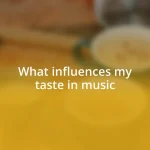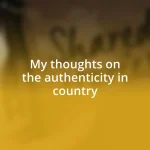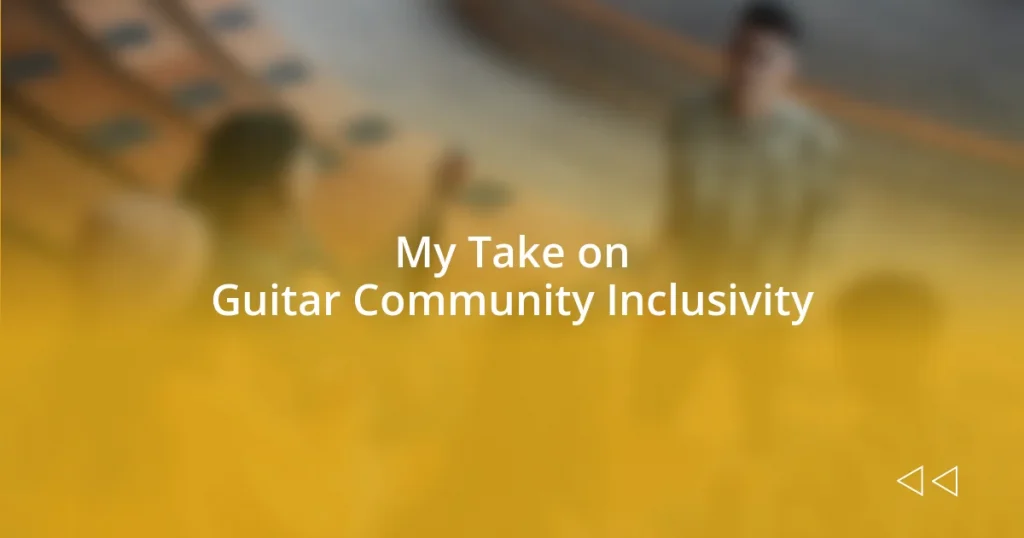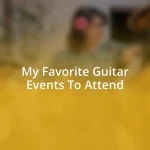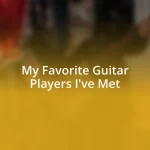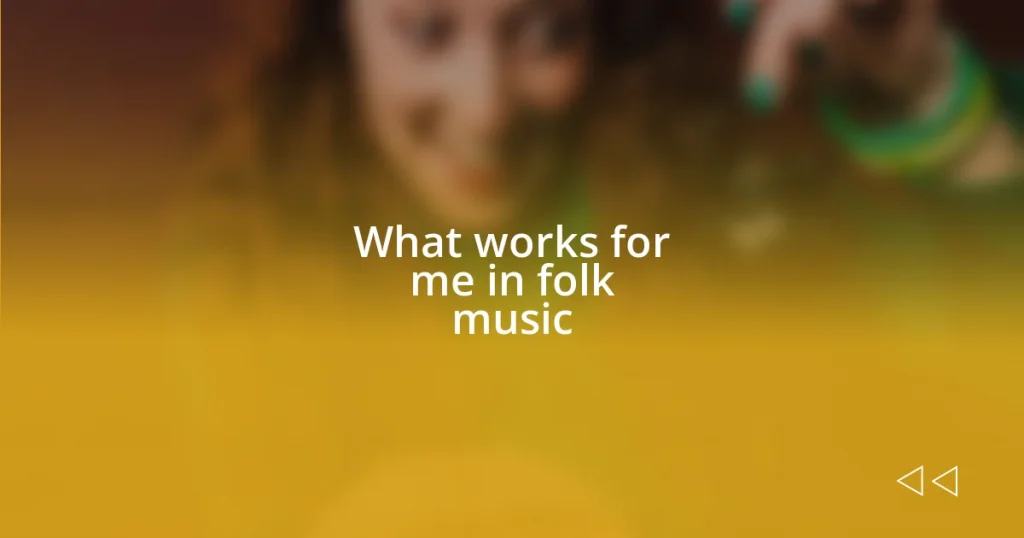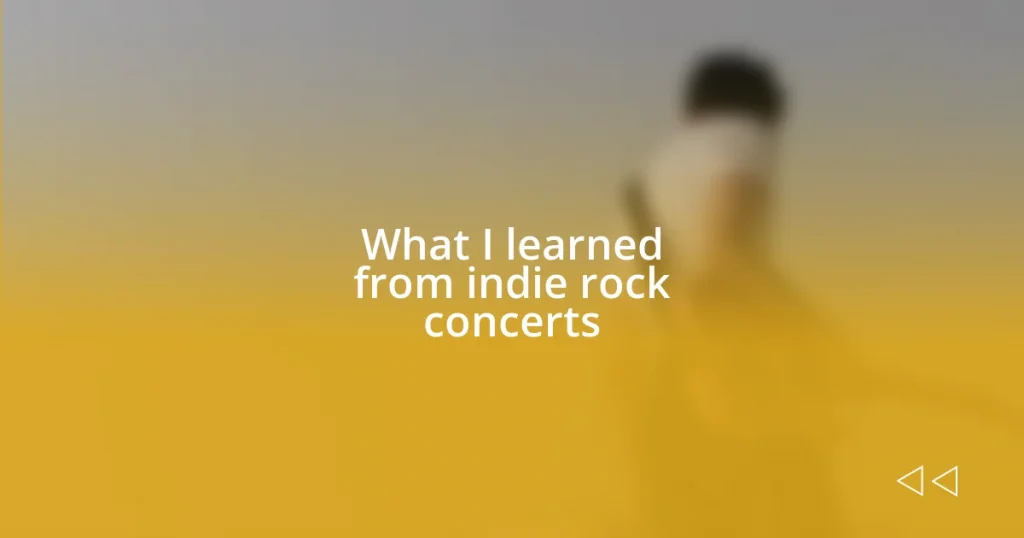Key takeaways:
- Diversity in the guitar community enhances creativity and fosters connections, highlighting the importance of inclusivity for all musicians.
- Challenges faced by diverse musicians include lack of representation, language barriers, and financial obstacles that hinder participation.
- Creating welcoming spaces through collaboration, mentorship, and celebrating diverse voices cultivates a supportive and innovative musical community.
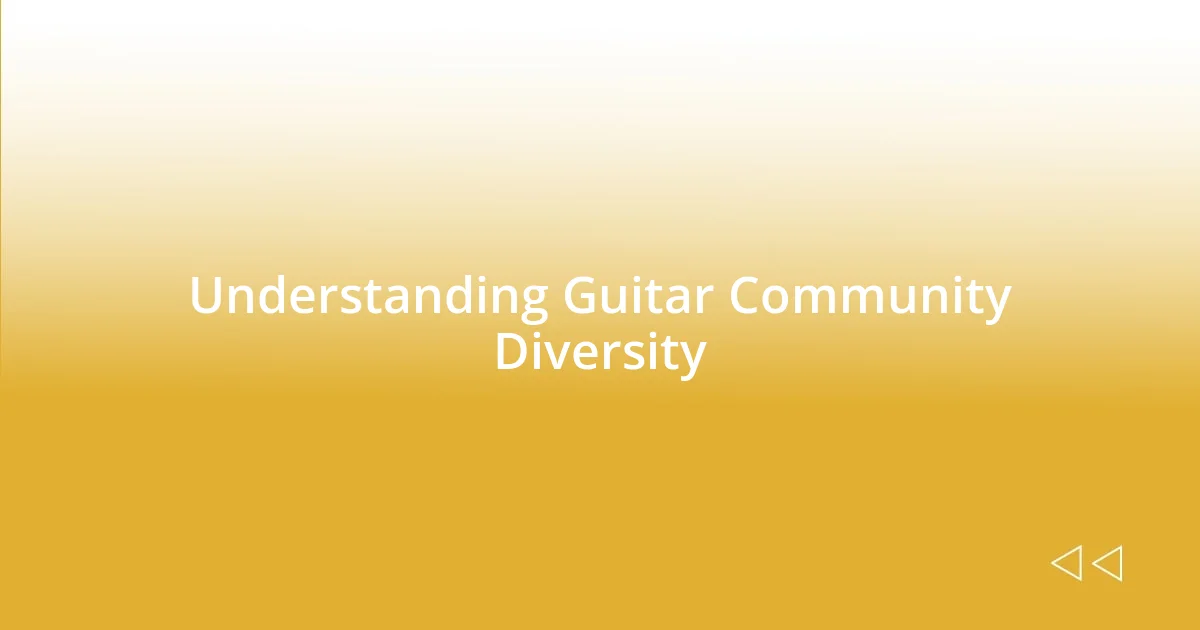
Understanding Guitar Community Diversity
Diversity in the guitar community isn’t just about different playing styles—it reflects unique backgrounds and cultural influences. I remember jamming with a group of musicians from various countries, each bringing their own flair to traditional riffs. It made me realize how music is a universal language that bridges gaps, fostering connections that transcend cultural differences.
I often wonder how many aspiring guitarists feel like they don’t fit into the typical mold of the community. When I first started, I felt that way too, often struggling to find a place among more seasoned players. It wasn’t until I attended a local guitar meetup that I discovered fellow beginners and experienced players alike, all sharing tips and encouragement. That moment truly opened my eyes to the vibrant tapestry of skills and experiences that form our community.
It’s fascinating to consider how each guitarist’s journey is shaped by individual experiences, bringing a wealth of stories to the table. Personally, I’ve enjoyed collaborating with self-taught musicians who’ve developed their own methods, proving that there’s no one “right” way to play the guitar. This realization reinforces the idea that inclusivity—embracing all types of musicians, regardless of their background—cultivates a richer, more innovative community.
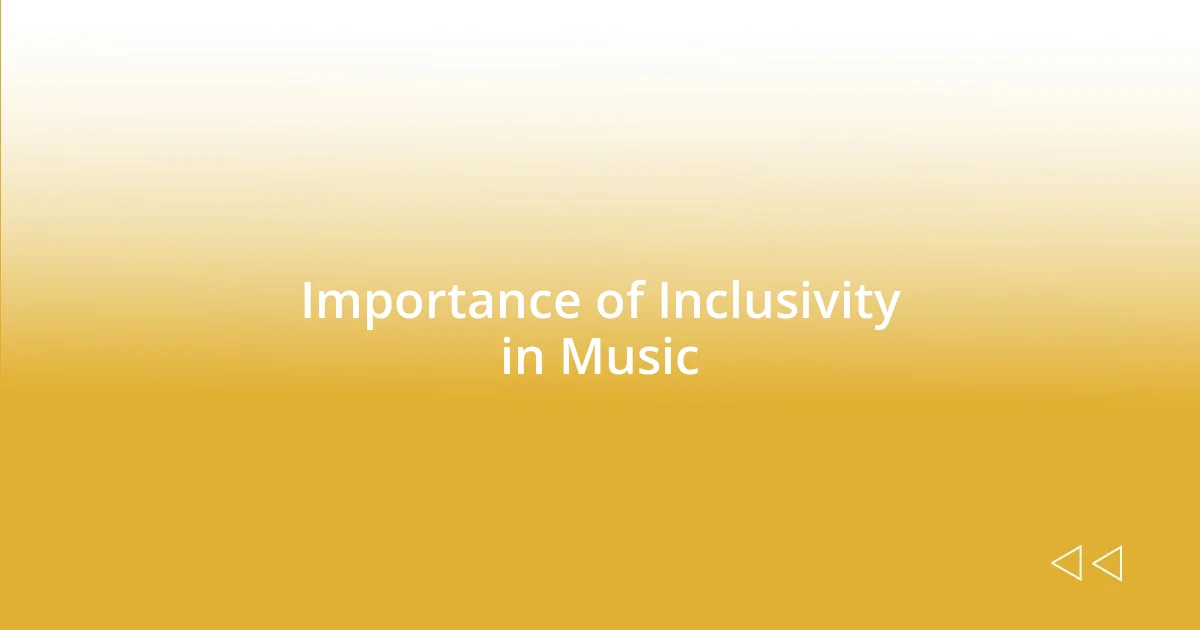
Importance of Inclusivity in Music
Music is a powerful tool for fostering inclusivity, as it has a unique ability to unite people from all walks of life. I vividly remember my first experience at an open mic night. There was such a diverse lineup—local artists of different ages, ethnicities, and skill levels sharing their stories through music. Watching how their differing backgrounds shaped their performances made me appreciate the beauty of varied perspectives. It hit me then that inclusivity isn’t just beneficial; it’s essential for a thriving musical ecosystem.
Here are a few key points on why inclusivity in music matters:
- Creativity Flourishes: A diverse group of musicians generates a richer pool of ideas, leading to innovative sounds and compositions.
- Broader Audience Engagement: Embracing different backgrounds allows music to resonate with a wider audience, fostering deeper connections.
- Empowerment Through Representation: When musicians see themselves reflected in the community, it encourages them to share their voices and stories, enhancing the collective narrative of music.
- Strengthened Community Bonds: Music thrives on collaboration, and inclusive practices promote a sense of belonging, making everyone feel valued in the musical journey.
- Increased Learning Opportunities: Interactions with varied musical styles and traditions offer opportunities for growth and expansion of skills for all musicians involved.
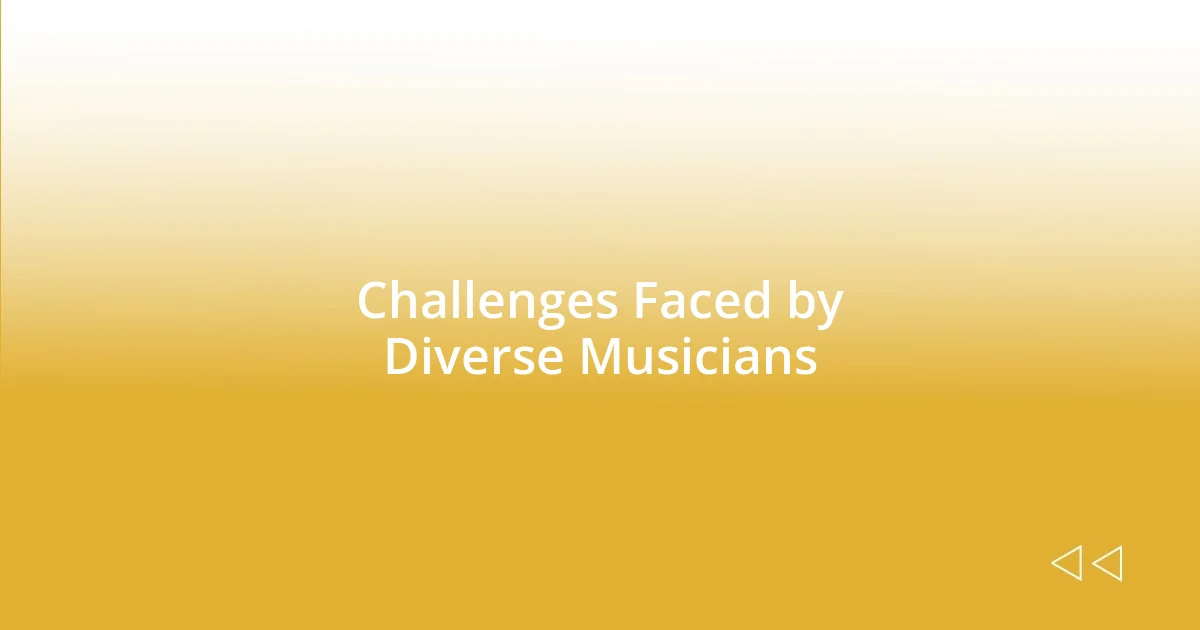
Challenges Faced by Diverse Musicians
Facing challenges is an inevitable part of being a musician, especially for those from diverse backgrounds. From my experience, one of the significant hurdles is the lack of representation in prominent music circles. I can’t tell you how many times I’ve attended concerts where the line-up was overwhelmingly homogenous. This absence can make aspiring musicians feel invisible, as if their unique stories and contributions are less valid or relevant.
Another layer to consider is the language barrier that often exists in music communities. I remember collaborating with a talented guitarist from a non-English speaking country. While our love for music transcended words, communication during practice sessions sometimes felt daunting. It was a reminder that creating an inclusive atmosphere goes beyond embracing cultural differences; it also involves fostering understanding and support that can help diverse musicians thrive collectively.
Ultimately, financial obstacles are also a pressing concern. Many musicians I know struggle to afford quality instruments or learning resources. I’ve witnessed friends shy away from opportunities due to the high cost of lessons or gear. These financial barriers can be especially pronounced for musicians from underprivileged backgrounds, inhibiting their ability to participate fully in the music community and share their talents.
| Challenges | Description |
|---|---|
| Lack of Representation | Many diverse musicians don’t see themselves in mainstream music, leading to feelings of invisibility. |
| Language Barriers | Communication issues can hinder collaborations, even in the universal language of music. |
| Financial Obstacles | High costs of instruments and lessons can restrict participation for aspiring musicians. |
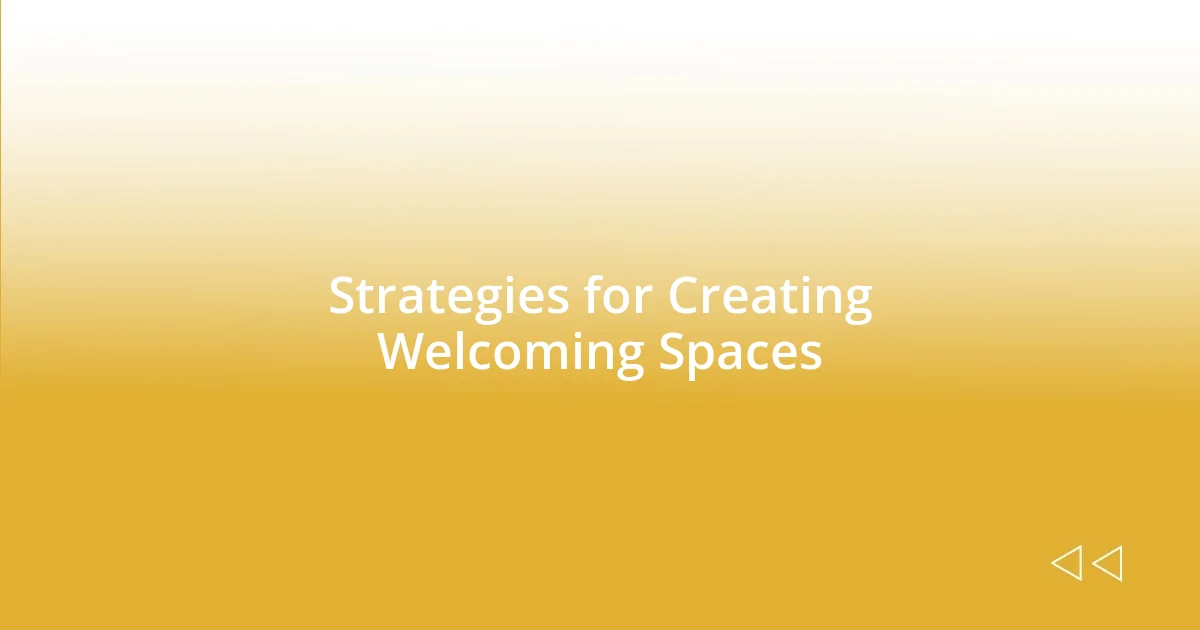
Strategies for Creating Welcoming Spaces
Creating welcoming spaces within the guitar community is essential for fostering inclusivity and connection. One effective strategy I’ve seen in action is organizing regular jam sessions that prioritize collaboration over competition. I remember participating in a local jam where everyone—regardless of skill level—was encouraged to share their unique sound. It felt magical to see beginners confidently strumming alongside seasoned musicians. This kind of environment invites participation and celebrates everyone’s contributions, making it clear that every voice matters.
Another powerful approach is to actively promote workshops that explore diverse musical styles and techniques. I once attended a workshop that focused on world music; it opened my eyes to different cultural perspectives in guitar playing. The sense of excitement was palpable as musicians experimented with unfamiliar rhythms and scales. Such initiatives not only enhance one’s technical abilities but also create a sense of community and shared learning. After all, how can we grow if we’re only exposed to one musical tradition?
Lastly, incorporating clear and respectful communication guidelines within community spaces can also make a significant difference. For instance, during my time coordinating a guitar meetup, we established a code of conduct that emphasized respect, encouragement, and active listening. This small step transformed our gatherings into safe spaces where everyone felt comfortable expressing themselves. Isn’t it wonderful how a few simple guidelines can help dismantle barriers and foster genuine connections? Ultimately, creating welcoming spaces is about cultivating an environment where everyone feels valued, heard, and empowered to participate fully.
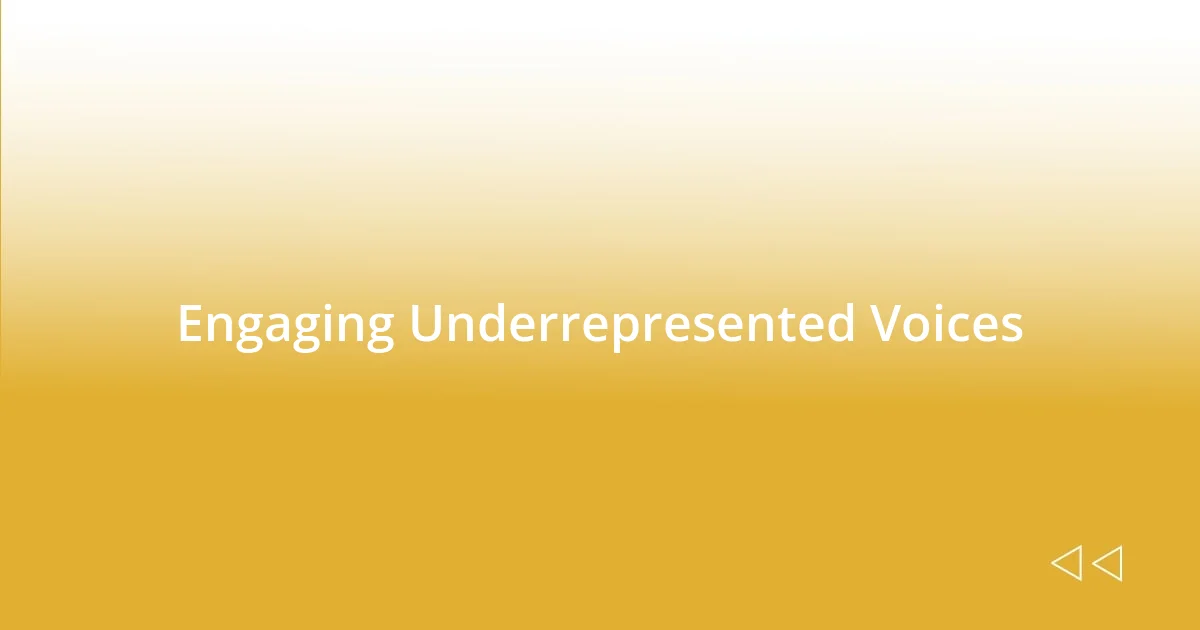
Engaging Underrepresented Voices
I’ve noticed that engaging underrepresented voices begins with listening. I remember one evening at an open mic night, where a young female guitarist took the stage for the first time. Her nervous energy was palpable as she shared a song infused with her cultural heritage. The audience was silent, leaning in—completely captivated. That moment underscored for me the importance of creating platforms where these voices can not only be heard but celebrated.
Moreover, actively seeking collaboration within diverse communities can lead to profound musical innovations. Recently, I partnered with musicians from different backgrounds to create a unique project blending various genres. As we exchanged ideas and built upon each other’s influences, I was amazed by how much richer our sound became. It makes me wonder—how much untapped potential do we overlook when we don’t actively engage with diverse perspectives?
Lastly, it’s essential to amplify these voices through supportive mentorship. I once mentored a young guitarist who felt out of place in her local scene. By nurturing her talent and connecting her with like-minded musicians, I watched her flourish. The joy on her face when she landed her first gig was indescribable. Reflecting on this, I realize that mentorship not only boosts individual confidence but also strengthens the community’s fabric. How can we foster inclusivity if we don’t lift each other up? Each of us has a role in creating a space where everyone can shine.
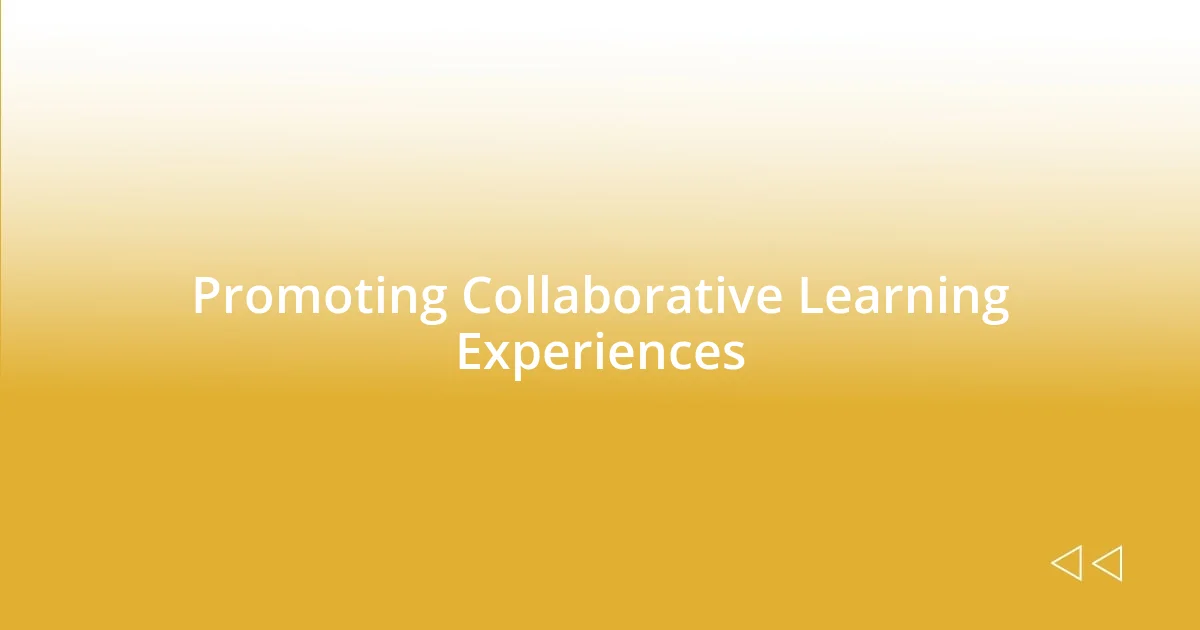
Promoting Collaborative Learning Experiences
When I think about promoting collaborative learning experiences within the guitar community, one memory stands out: a weekend retreat we organized for players of all levels. Imagine this—a cozy cabin, guitars in hand, and people forming small circles to share songs and techniques. It was incredible to witness how even the most timid players found their voice among others who were equally excited to learn. Those informal settings naturally encourage sharing knowledge and ideas, don’t they? After all, isn’t collaboration at the heart of creating something beautiful together?
I find that facilitating group challenges can also elevate collaborative learning experiences. Take, for instance, a friendly songwriting competition I participated in. Each group was tasked with crafting a song in just a few hours using prompts we generated together. The dynamic energy was electric as we built off each other’s creativity, bouncing ideas back and forth. It struck me how much we can achieve when we remove the pressure of individual performance and focus instead on the power of teamwork. Have you ever noticed how collaboration opens doors to unexpected musical directions?
Another enriching experience I cherish involved organizing a community workshop where everyone taught something they loved. One gifted player showed us how to use alternate picking techniques, while another introduced fingerstyle patterns that blew my mind. As I observed musicians encouraging one another, I felt a wave of fulfillment wash over me. How rewarding it is to see each person’s unique contribution appreciated! It’s moments like these that reinforce my belief in the transformative power of collaboration—every experience, no matter how small, adds to the tapestry of our collective growth.
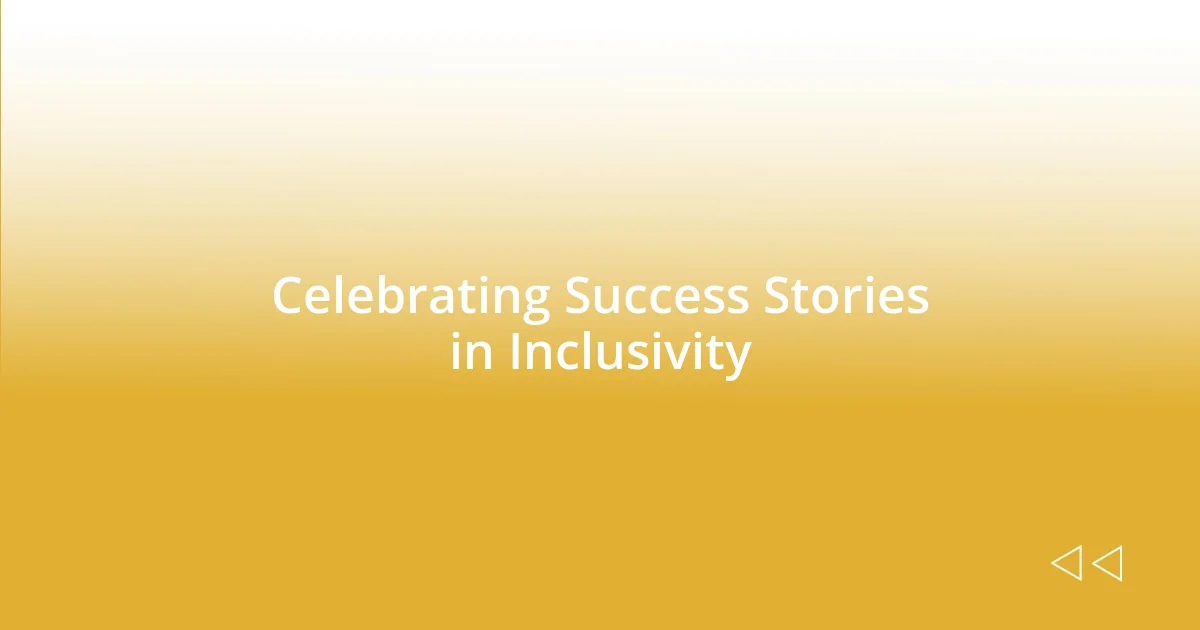
Celebrating Success Stories in Inclusivity
In celebrating success stories in inclusivity, I often reflect on a local concert that featured artists from different backgrounds, all united by their love for music. Watching a talented guitarist who overcame significant obstacles perform, I felt a rush of pride for not just her journey, but for the entire community that supported her. Wasn’t it amazing how her performance resonated with so many of us, creating a sense of shared experience? It reminded me that inclusivity isn’t just a buzzword; it’s a powerful force that nurtures growth and connection.
One particularly unforgettable moment came when a friend invited me to a cultural exchange event where we shared our musical styles. I remember standing in awe as a group of children, some just learning to play, confidently stepped up to share their original compositions. The smiles on their faces were contagious as they received encouragement from players of all ages. How often do we underestimate the impact of simply providing a space for expression? That night, the air was charged with a sense of possibility, and I couldn’t help but feel grateful to be part of such a vibrant community.
It’s also heartwarming to see initiatives designed to elevate underrepresented voices. In one instance, I volunteered at a youth program where passionate young musicians learned together, regardless of skill level. It was a powerful experience watching them bond over their mutual love of music, guiding and inspiring each other. This made me wonder—what if every community had access to such inclusive environments? Success stories like these remind us that fostering a welcoming atmosphere not only enriches our local scenes but also empowers individuals to dream bigger.


